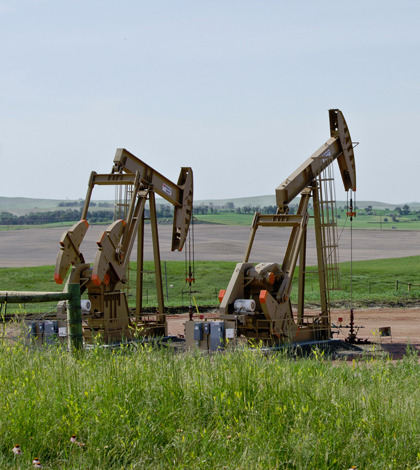Soil, Water Contamination In North Dakota From Fracking Spills

Oil well in North Dakota. (Credit: Flickr User Tim Evanson via Creative Commons 2.0)
Accidental wastewater spills from unconventional oil production in North Dakota have caused widespread water and soil contamination, a new Duke University study finds. Streams polluted by the wastewater contained levels of contaminants that often exceeded federal guidelines for safe drinking water or aquatic health.
Researchers found high levels of ammonium, selenium, lead and other toxic contaminants as well as high salts in the brine-laden wastewater, which primarily comes from hydraulically fractured oil wells in the Bakken region of western North Dakota.
Soil at the spill sites was contaminated with radium, a naturally occurring radioactive element found in brines, which chemically attached to the soil after the spill water was released. At one site, the researchers were still able to detect high levels of contaminants in spill water four years after the spill occurred.
Until their study, researchers say that other investigations in many regions of the nation have shown that contamination from fracking has been fairly sporadic and inconsistent. But in North Dakota, it appears to be widespread and persistent, with clear evidence of direct water contamination from fracking.
Perhaps that’s because the magnitude of drilling in North Dakota is so great. More than 9,700 wells have been drilled there in the past decade. This massive development has led to more than 3,900 brine spills, mostly coming from faulty pipes built to transport fracked wells’ flowback water from on-site holding containers to nearby injection wells built to dispose of it underground.

Duke University students sample water and soil. (Photo: Avner Vengosh / Duke University)
As part of the study, the team mapped the distribution of the 3,900 spill sites to show how they were associated with the intensity of the oil drilling. Researchers also collected samples of brine-laden spill waters from four sites – two large spills and two smaller ones.
They measured and analyzed the samples for inorganic contaminants and to identify the unique isotopic signature, or fingerprint, of Bakken region brines. By comparing this fingerprint to the geochemical and isotopic profiles of 29 background surface water samples collected across the region, the team was able to determine where and to what extent contamination associated with brine spills had occurred, and rule out the possibility that it had been caused by other sources.
In addition, soil samples collected downstream from spill sites contained higher levels of radioactivity than soil at the spill sites themselves. This suggests that radium builds up in the soil as the spilled brine flows through the environment.
North Dakota’s unconventional oil production grew from about 100,000 barrels a day in 2007 to more than 1 million barrels a day in 2014. Much of the increased production has been made possible by advances in hydraulic fracturing and horizontal drilling. The industry’s expansion in North Dakota has fueled economic growth, especially on tribal lands and in rural areas, but also has sparked concerns about drinking water contamination.
The Duke team published its peer-reviewed study in the journal Environmental Science & Technology. Funding came from the National Science Foundation and the Natural Resources Defense Council.
Top image: Oil well in North Dakota. (Credit: Flickr User Tim Evanson via Creative Commons 2.0)




0 comments